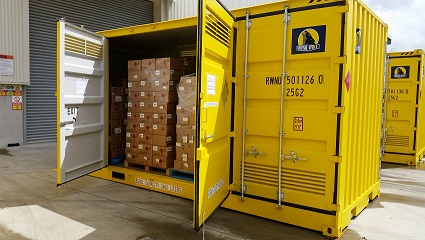The Warehouse is using specially modified shipping containers to ensure thousands of bottles of perfume and nail polish are stored safely and securely.
The Warehouse Group Ltd is one of many companies using Royal Wolf’s dangerous goods containers to meet its hazardous goods storage requirements in order to meet new health and safety laws that demand tighter controls for dangerous substances.
Warehouse Group wholesale inbound & inventory manager Jasmine Taylor says the containers provide additional storage for products such as perfume and nail polish when its onsite dangerous goods bunker in Albany is at capacity.
“While nail polish and perfume are beauty accessories, in large quantities they are a high-risk product – when they are stored together they produce a hazardous atmospheric mixture,” she says.
“So it’s about reducing the risk of a massive fire or explosion, and our specially designated dangerous goods bunker is the safest way to store these sorts of products.”
The containers, which are approved to hold 2,000 litres of product each, are required to be at least three metres away from buildings or other dangerous goods units.
“The containers are an efficient and versatile storage function that is ideal for logistics operations needing extra capacity,” Taylor says.
“So for us, especially ahead of our busy Christmas holiday period when all of our racks are full, having stock still within our site that we can access easily is essential. The containers are a huge support to our business, especially with the growth we are currently experiencing.”
Royal Wolf’s executive general manager New Zealand Paul Creighton says the containers are used across a wide range of industries – everything from paint storage at panel beaters through to the horticulture and agriculture sectors for storage of hazardous chemicals and sprays.
“Under New Zealand’s new Health and Safety laws more emphasis has been put on the safe storage of flammable and toxic goods and these units are a safe and easy way to keep these potentially harmful items secure,” he maintains.
Creighton adds that many businesses and workplaces use dangerous substances on a daily basis and because people are dealing with them so often it can be easy to take it for granted. “But with WorkSafe NZ estimating between 500-800 New Zealanders die from occupational illness every year, many of which are caused by exposure to dangerous substances, it’s an issue that needs to be taken seriously.”
WorkSafe NZ defines hazardous substances as “substances that are explosive, flammable, oxidising, corrosive or toxic to the environment. They can be a single chemical or a mixture of both hazardous and non-hazardous chemicals. Most products used in workplaces are a mixture of chemicals.”




